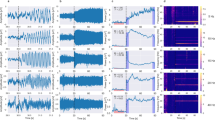Abstract
Monitoring of somatosensory, motor and auditory pathway function by evoked potentials is routine in surgery placing these pathways at risk. However, visual pathway function remains yet inaccessible to a reliable monitoring. For this study, a method of continuous recordings was developed and tested. Steady-state visual evoked potentials were elicited by flash stimulation at 16 Hz and analysed using discrete Fourier transform. Amplitude and phase of the fundamental response were dynamically averaged and continuously plotted in a trend graph. The method was applied on awake individuals with normal vision and on patients undergoing neurosurgery. In most individuals it was possible to continuously record significant responses. Surprisingly, characteristic time-courses of amplitude and phase were observed in several subjects. These findings were attributed mainly to flicker-adaptation. During anesthesia, amplitude and signal-to-noise ratio were markedly smaller. Signal recognition was facilitated when potentials were recorded with a subdural electrode placed directly at the occipital pole. The anesthetic agent propofol had a major impact on the recordings.








Similar content being viewed by others
Abbreviations
- AEP:
-
auditory evoked potential
- EP:
-
evoked potential
- DFT:
-
discrete Fourier transform
- LED:
-
light emitting diode
- RAPD:
-
relative afferent pupillary defect
- SEP:
-
sensory evoked potential
- SNR:
-
signal-to-noise ratio
- SSEP:
-
somatosensory evoked potential
- ssVEP:
-
steady-state visual evoked potential
- TIVA:
-
total intravenous anesthesia
- tVEP:
-
transient visual evoked potential
- VEP:
-
visual evoked potential
References
Burke D, Nuwer MR, Daube J, Fischer C, Schramm J, Yingling CD, Jones SJ (1999) Intraoperative monitoring. Electroencephalogr Clin Neurophysiol Suppl 52:133–148
Nuwer MR, Dawson EG, Carlson LG, Kanim LEA, Sherman JE (1995) Somatosensory evoked potential monitoring reduces neurologic deficits after scoliosis surgery: results of a large multicenter survey. Electroencephalogr Clin Neurophysiol 96:6–11
Russ W, Krumholz W, Hempelmann G (1984) Visuell evozierte Potentiale (VEP) in Anästhesie und Intensivmedizin. Anaesthesist 33:154–160
Sloan TB (1996) Evoked potential monitoring. Int Anesthesiol Clin Summer 34(3):109–36
Raudzens PA (1982) Intraoperative monitoring of evoked potentials. Ann NY Acad Sci 55:308
Lorenz M, Renella RR (1989) Intraoperative monitoring: visual evoked potentials in surgery of the sellar region. Zentralbl Neurochir 50(1):12–15
Cedzich C, Schramm J, Mengedoht CF, Fahlbusch R (1988) Factors that limit the use of flash visual evoked potentials for surgical monitoring. Electroencephalogr Clin Neurophysiol 71:142–145
Cedzich C, Schramm J, Fahlbusch R (1987) Are flash-evoked visual potentials useful for intraoperative monitoring of visual pathway function? Neurosurgery 21(5):709–715
Wiedemayer H, Fauser B, Sandalcioglu IE, Armbruster W, Stolke D (2004) Observations on intraoperative monitoring of visual pathways using steady-state visual evoked potentials. Eur J Anaesthesiol 21:429–433
Harding GFA, Bland JDP, Smith VH (1990) Visual evoked potential monitoring of optic nerve function during surgery. J Neurol Neurosurg Psychiatry 53:890–895
Herzon GD, Zealear DL (1994) Intraoperative monitoring of the visual evoked potential during endoscopic sinus surgery. Otolaryngol Head Neck Surg 111(5):575–579
Hussain SSM, Laljee HCK, Horrocks JM, Tec H, Grace ARH (1996) Monitoring of intra-operative visual evoked potentials during functional endoscopic sinus surgery (FESS) under general anaesthesia. J Laryngol Otol 110:31–36
Chacko AG, Babu KS, Chandy MJ (1996) Value of visual evoked potential monitoring during trans-sphenoidal pituitary surgery. Br J Neurosurg 10:275–278
Hajek A, Zrenner E (1988) Verbesserte objektive Visusprüfung mit visuell evozierten corticalen Potentialen durch schnelle Reizmustersequenzen unterschiedlicher Raumfrequenz. Fortschr Ophthalmol 85:550–554
Peachey NS, Demarco Jr PJ, Ubilluz R, Yee W (1994) Short-term changes in the response characteristics of the human visual evoked potential. Vision Res 34(21):2823–2831
Heine M, Meigen T (2004) The dependency of simultaneously recorded retinal and cortical potentials on temporal frequency. Doc Ophthalmol 108:1–8
Harding G, Wilkins AJ, Erba G, Barkley GL, Fisher RS (2005) Photic- and pattern-induced seizures: expert consensus of the epilepsy foundation of America working group. Epilepsia 46(9):1423–1425
Meigen T, Bach M (2000) On the statistical significance of electrophysiological steady-state responses. Doc Ophthalmol 98:207–232
Wiedemayer H, Fauser B, Armbruster W, Gasser T, Stolke D (2003) Visual evoked potentials for intraoperative neurophysiologic monitoring using total intravenous anesthesia. J Neurosurg Anesthesiol 15(1):19–24
Pratt H, Martin WH, Bleich N, Zaaroor, Schacham SE (1994) A high-intensity. goggle-mounted flash-stimulator for short-latency visual evoked potentials. Electroencephalogr Clin Neurophysiol 92:469–472
Rudner R, Jalowiecki P, Hagihira S (2005) Abnormally low bispectral index and isoelectric electroencephalogram observed after administration of small doses of propofol during induction of anesthesia. J Anesth 19:339–342
Hamaguchi K, Nakagawa I, Hidaka S, Uesugi F, Kubo T, Kato T (2005) Effect of propofol on visual evoked potentials during neurosurgery. Masui 54(9):998–1002
Chi OZ, Field C (1990) Effects of enflurane on visual evoked potentials in humans. Br J Anaesth 64:163–166
Zaaror M, Pratt H, Feinsod M, Schacham SE (1993) Real-time monitoring of visual evoked potentials. Israel J Med Sci 29:17–22
Herrmann CS (2001) Human EEG responses to 1–100 Hz flicker: resonance phenomena in visual cortex and their potential correlation to cognitive phenomena. Exp Brain Res 137:346–353
Xin D, Seiple W, Holopigian K, Kupersmith MJ (1994) Visual evoked potentials following abrupt contrast changes. Vision Res 34(21):2813–2821
Ho WA, Berkley MA (1988) Evoked potential estimates of the time course of adaptation and recovery to counterphase gratings. Vision Res 28(12):1287–1296
Greenlee MW, Heitger F (1988) The functional role of contrast adaptation. Vision Res 28(7):791–797
Heinrich SP, Bach M (2001) Adaptation dynamics in pattern-reversal visual evoked potentials. Doc Ophthalmol 102:141–156
Shady S, MacLeod DIA, Fisher HS (2004) Adaptation from invisible flicker. PNAS 101(14):5170–5173
Anstis A (1996) Adaptation to peripheral flicker. Vision Res 36(21):3479–3485
Barlow HB, Macleod DIA, van Meeteren A (1976) Adaptation to gratings: no compensatory advantages found. Vision Res 16:1043–1045
Author information
Authors and Affiliations
Corresponding author
Rights and permissions
About this article
Cite this article
Bergholz, R., Lehmann, T.N., Fritz, G. et al. Fourier transformed steady-state flash evoked potentials for continuous monitoring of visual pathway function. Doc Ophthalmol 116, 217–229 (2008). https://doi.org/10.1007/s10633-007-9085-6
Received:
Accepted:
Published:
Issue Date:
DOI: https://doi.org/10.1007/s10633-007-9085-6




